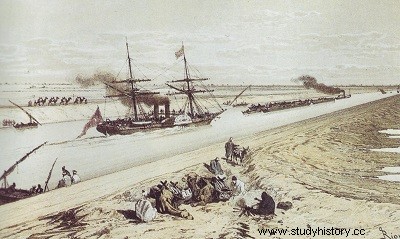
Lesseps beamed. A platform had been erected facing the channel from which the waters entered the basin of the Bitter Lakes. Thin mobile beams were arranged along the sluice-spillway, and workers stood on a footbridge, ready to remove them to allow the water to pass. The khedive gives the signal, and the first beam of the central span is released. Immediately a jet of seawater rushes through the opening, with a shrill noise. The other beams are successively removed:the jet becomes a whitish sheaf, then a waterfall which shines in the sun. Two, three, four, twenty spans open in turn, and from all sides the stream springs...
Finally the five hundred beams are raised; and the sheet of water, having become general, is a torrent which roars past and soon changes into a muddy river reaching the center of the basin of the Bitter Lakes... The Mediterranean hastened to lend its aid to the completion of a the most marvelous works of human genius.
Between the Bitter Lakes and the Red Sea, there soon remained only five kilometers of canal to be dug. The workers redoubled their ardour. One read in the eyes of the European workers the pride of the daily task accomplished, the pride of the advancement achieved, the ambition to exceed the day after the record of the day before.
As for the fellahs , for the first time, no doubt, in the history of their race they were happy; they received wages for their work and no longer had any fear of perishing from hunger, thirst or misery.
The construction of the Cairo railway had cost the lives of about ten thousand fellahs; in 1868, mortality in the isthmus, in spite of fifteen million cubic meters of earth or silt removed, transported, handled, was established at 1.52%, while in France, at the same time, it reached 2.40%!
Lesseps was deeply delighted by these unsuspected results. This, too, was his reward; a lasting reward, because, if the good general sanitary condition had to be attributed in part to the hygiene of the accommodation and the abundance of food
ture, Lesseps knew that it had contributed also, and would continue to contribute to it from now on, the lowering of the temperature and the appearance of the rains, hitherto unknown in the isthmus, resulting from the new presence of the vast water surfaces of the canal.
On August 15, new festivals were held in Suez to celebrate the junction, in the Bitter Lakes, of the waters of the Mediterranean and the Red Sea. The operation went off with the greatest success. It was as if the two seas, which had already been mingled together a few thousand years earlier, recognized each other.
At these ceremonies, Ali Pasha Mubarek, Minister of Public Works to the Khedive, represented the absent viceroy. At the time, he was on a long trip to Europe, where he had gone to invite the sovereigns of the great powers to the inauguration of the maritime canal.
The next day, August 16, the administration of the Suez Canal Company published its Navigation Regulations. [I started like this:
ART. 1st — Navigation on the Suez maritime canal is permitted to all ships, whatever their nationality, provided that they do not stall more than 7.50 meters, the canal being 8 meters deep.
Steamships will be able to navigate the canal with their own propeller.
Three months later, on November 16, 1869, the solemn celebrations of the inauguration of the Suez Canal began.
For the solemn inauguration of the canal, Lesseps had discreetly made way for the khedive Ismaïl pasha, sovereign of Egypt, and the latter, flattered that so much glory seemed to go to him personally, had wanted to receive his guests in a setting and with a splendor that evoked for them a tale from the "Thousand and One Nights".
